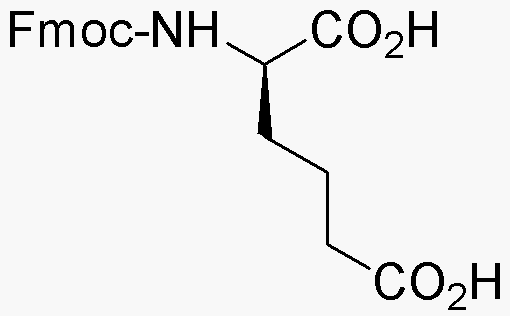Fmoc-D-a-aminoadipic acid is widely utilized in research focused on:
- Peptide Synthesis: This compound serves as a protective group in solid-phase peptide synthesis, allowing for the selective modification of amino acids without affecting the overall structure.
- Drug Development: It plays a crucial role in the design of peptide-based therapeutics, enhancing the stability and bioavailability of drug candidates.
- Biotechnology: Researchers use it in the development of novel biomaterials, leveraging its properties to create hydrogels and scaffolds for tissue engineering applications.
- Analytical Chemistry: The compound is utilized in various analytical techniques, including chromatography, to help separate and identify complex mixtures of peptides and proteins.
- Academic Research: It is frequently employed in laboratories for educational purposes, allowing students and researchers to explore peptide chemistry and its applications in a hands-on manner.
Informations générales
Propriétés
Sécurité et réglementation
Applications
Fmoc-D-a-aminoadipic acid is widely utilized in research focused on:
- Peptide Synthesis: This compound serves as a protective group in solid-phase peptide synthesis, allowing for the selective modification of amino acids without affecting the overall structure.
- Drug Development: It plays a crucial role in the design of peptide-based therapeutics, enhancing the stability and bioavailability of drug candidates.
- Biotechnology: Researchers use it in the development of novel biomaterials, leveraging its properties to create hydrogels and scaffolds for tissue engineering applications.
- Analytical Chemistry: The compound is utilized in various analytical techniques, including chromatography, to help separate and identify complex mixtures of peptides and proteins.
- Academic Research: It is frequently employed in laboratories for educational purposes, allowing students and researchers to explore peptide chemistry and its applications in a hands-on manner.
Documents
Fiches de données de sécurité (FDS)
La FDS fournit des informations de sécurité complètes sur la manipulation, le stockage et l’élimination du produit.
Spécifications du produit (PS)
Le PS fournit une description complète des propriétés du produit, notamment sa composition chimique, son état physique, sa pureté et les exigences de stockage. Il détaille également les plages de qualité acceptables et les applications prévues du produit.
Certificats d'analyse (COA)
Recherchez des certificats d'analyse (COA) en saisissant le numéro de lot du produit. Les numéros de lot et de lot se trouvent sur l'étiquette d'un produit, après les mots « Lot » ou « Lot de fabrication ».
Numéro de catalogue
Numéro de lot/série
Certificats d'origine (COO)
Ce certificat d'exploitation confirme le pays dans lequel le produit a été fabriqué, et détaille également les matériaux et composants utilisés et s'il est issu de sources naturelles, synthétiques ou autres sources spécifiques. Ce certificat peut être requis pour les douanes, le commerce et la conformité réglementaire.
Numéro de catalogue
Numéro de lot/série
Fiches de données de sécurité (FDS)
La FDS fournit des informations de sécurité complètes sur la manipulation, le stockage et l’élimination du produit.
DownloadSpécifications du produit (PS)
Le PS fournit une description complète des propriétés du produit, notamment sa composition chimique, son état physique, sa pureté et les exigences de stockage. Il détaille également les plages de qualité acceptables et les applications prévues du produit.
DownloadCertificats d'analyse (COA)
Recherchez des certificats d'analyse (COA) en saisissant le numéro de lot du produit. Les numéros de lot et de lot se trouvent sur l'étiquette d'un produit, après les mots « Lot » ou « Lot de fabrication ».
Numéro de catalogue
Numéro de lot/série
Certificats d'origine (COO)
Ce certificat d'exploitation confirme le pays dans lequel le produit a été fabriqué, et détaille également les matériaux et composants utilisés et s'il est issu de sources naturelles, synthétiques ou autres sources spécifiques. Ce certificat peut être requis pour les douanes, le commerce et la conformité réglementaire.


